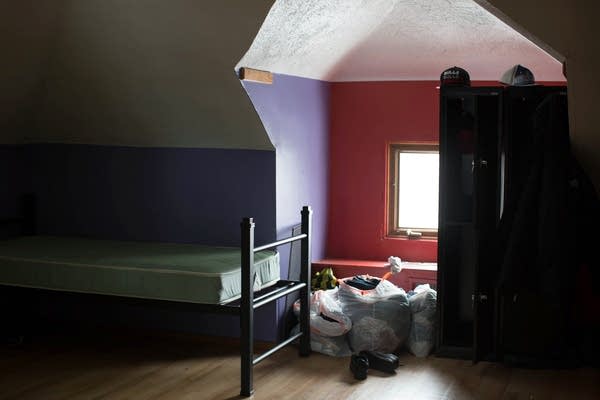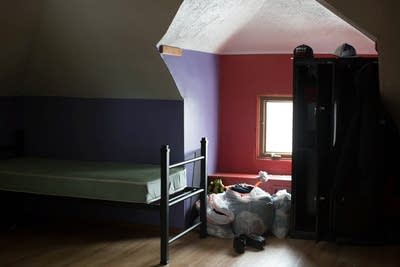Homeless youth find refuge at Safe House in St. Paul

From the outside, Safe House is just a non-descript home in a residential neighborhood in St. Paul. On the inside though, what is accomplished goes beyond four walls.
The house has served as a landing spot for young homeless people for more than 20 years and could gain from a bill moving through the state Legislature. The Homeless Youth Act passed out of the Health and Human Services Finance Committee in the Minnesota House Thursday.
The bill — which lists both Democrats and Republicans on its sponsor list — would provide $8 million in state funding to address youth homelessness. The bill is supported by a coalition of community and faith-based organizations like Lutheran Social Service, the Wilder Foundation and Catholic Charities.
Wilder estimates that on any given night, 2,500 young people are homeless in our state. Little more than 100 emergency beds are available for young people in Minnesota — 90 of which are in the Twin Cities.
Create a More Connected Minnesota
MPR News is your trusted resource for the news you need. With your support, MPR News brings accessible, courageous journalism and authentic conversation to everyone - free of paywalls and barriers. Your gift makes a difference.
To get a better sense of the particular challenges facing homeless youth, Tom Crann of MPR's All Things Considered visited Safe House and met with Lutheran Social Service metro homeless youth program director Susan Phillips and a young woman who's experienced homelessness.
An edited version of their conversation is below.
Tom Crann: We're here in the entry way, Susan, a house that looks like a lot of the houses in the neighborhood. Right off the entry way there is this nook, a little office area?
Susan Phillips: There is a computer for the young people to use, to stay connected to school, to check their email, to apply for jobs, to check in with social media. It's important for young people.
Safe House provides overnight emergency shelter for young people who are experiencing homelessness between the ages of 16 and 21. It's a roof and a bed and a place that provides basic needs, but it's very much more than that. Each young person who stays at Safe House works one-on-one with a case manager, to sort of process where they've been; what has happened in their life; what experiences they've had with resiliency; what they hope for in the future.
Crann: How many kids a night or at any time can you serve here?
Phillips: We are licensed only for six because of zoning in the neighborhood. We physically have 10 beds.
"I know outreach workers in the past have given young people enough tokens to ride the buses all night."
Crann: Do kids find about it and you have to turn them away? Do they show up at the door?
Phillips: We turn away two to 12 calls a night. So we serve less than we turn away.
Crann: What happens to those kids?
Phillips: Often times those youth are calling in the presence of a street outreach worker. And so we know that street outreach worker will continue to make phone calls and brainstorm resources. Is there some place you could stay for a night or two and then we'll connect back up again? I know outreach workers in the past have given young people enough tokens to ride the buses all night. It doesn't happen every day, but occasionally when it's cold.
Crann: This house you could drive by like any other on the block. How important is it just be a neighborhood house?
Phillips: I think it's important because some of the youth who come here are fleeing something dangerous. And they need to be in a place that people can't find them.
Another reason: I think being in a house in a big family setting normalizes life for a minute. It's not an institutional setting; it's not like juvenile corrections; it's not like sort of county referral shelter; it just feels like home. And I think that's really important for the young people who walk in the door every evening.
Crann: It feels like home. That's the atmosphere you're trying to maintain here?
Phillips: Absolutely. That's very intentional on our part. We want this to feel like home. And we really want people to come in the door and feel safe. Because when they're out there on the streets and engaged in survival, safety is the last thing that they have.
Crann: I know there's probably no typical story about how a kid would end up here, but in general, what sorts of challenges do they have have in their lives that they find themselves on the street?
Phillips: There are many pathways. They mostly are grounded in family conflict and dysfunction. Economic circumstances can exacerbate family conflict and make things worse and make things harder, but it's often that there's dysfunction, chemical abuse, unchecked mental health issues, bad parenting. Not because it's the parents fault, it's because they've been in a cycle they were parented poorly; they are now parenting in the same way they were parented without realizing it's not necessarily working.
Kids get to a point where they can walk out, and they do. They either choose to walk out because they know they know 'I will not live if I stay here,' or they are kicked out, and they are forced to leave.
COREY'S STORY
Crann: At Safe House, I met 19-year-old Corey, who didn't want us to use her last name. Corey, who describes herself as a full-time student, a youth activist and a full-time lover, found herself homeless three years ago.
Corey: It wasn't that I was being rebellious or out here doing the wrong thing. I had just graduated high school, I was 16 and I was looking for a job. I was really doing the things that a teenager was suppose to do but it still wasn't right for me at home.
Part of the reason that I became homeless was because of addictions and it wasn't really safe mentally physically or financially. I feel like youth make a very mature decision in knowing that it's not safe and they get out of that.

Crann: Corey was lucky to find help quickly once she decided to leave home: A chance meeting at a bus stop led her to a program called Youthlink, a non-profit that serves homeless kids in Minneapolis.
Corey: I went to Youthlink and got a case manager and signed up for a lot of apartments and things like that. The process was easy for me fortunately. But the process isn't always easy; some of my friends go homeless for months and months.
Crann: Can I ask what you're doing now?
Corey: I have my own place now. And I'm going to school at [Minneapolis Community and Technical College], I'm going to be transferring to the [University of Minnesota] in the fall. I'm an intern at Youthlink so I'm on the staff there. And I'm just really trying to do amazing things for youth and advocate for youth as much as I can, and focus on my studies and be surrounded by love.
WORKING TOWARD A WIN-WIN
Crann: We've heard Corey's story, how typical is that?
Phillips: Corey's story is fairly typical. I think what makes it unique is she didn't sort of languish in this "survival shelter-hopping" mode a long time. She got into housing quickly — that's not typical. Most young people because of the lack of resources sort of circle around from shelter to shelter and couch to couch waiting for an opening to come up.
She was lucky in that aspect. Her maturity, her hopefulness, her desire to give back to her community is very typical of the young people that we serve. That's why I come to work every day. It's a privilege.
Crann: And what don't people know about how vulnerable homeless young people are?
Phillips: Well, it's not rocket science. They're young, their brains are still developing, they aren't physically able to make really wise decisions all the time. It's the reason our kids live with us a long time.
And even after they graduate from high school, parents are still very involved in their children's lives as they go to college and graduate and move on. These kids are just supposed to figure it out by themselves?
When we acknowledge that these are young people who've experienced trauma, and we engage them in ways that respect their experiences, and we acknowledge their strengths, and we hold their hands through this process of learning how to be in the world, then what we get is productive contributing members of our communities. It's a win-win for all of us when we have that.
